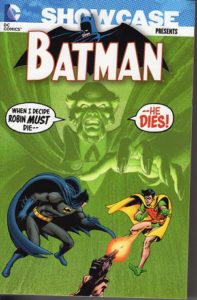Comic Book Review: Showcase Presents: Batman, Volume 6 edited by Julius Schwartz
By 1971, the Batman television show had been off the air long enough that its sales boost to the Batman and Detective Comics series had faded, and with it, the incentive to model the magazines on the show. Bruce Wayne moved from stately Wayne Manor to a penthouse in downtown Gotham City and started a charitable organization for victims of crime. Dick “Robin” Grayson went off to college on the other side of the state, and guest-starred infrequently. And most of Batman’s regular rogues’ gallery took a vacation.
This freed up space for a more somber tone, although this run certainly had its own silliness, such as a return engagement by the Ten-Eyed Man, whose optic nerves had been transplanted into his fingers. And Two-Face made an appearance for the first official time since the 1950s. But quite a few of the stories had Batman facing off against ordinary murderers and organized crime…as well as what appeared to be ghosts and psychic powers.
This volume covers Batman 229-236 and Detective Comics 408-416. The first story, “Asylum of the Futurians” pits the Caped Crusader against a group of apparent lunatics who’ve captured a photographer in the mistaken belief he possesses psychic abilities that will make him their leader. (It’s never clear that the Futurians actually have ESP; it certainly doesn’t help against Batman; but then how do you explain the sudden impulse he had to investigate the neighborhood?)
Several stories are topical to the 1970s. Thinly veiled versions of consumer advocate Ralph Nader and “participatory journalist” George Plimpton make guest appearances. Stories featuring youth activism and black radicals have aged poorly; the latter mixes in a police corruption subplot, the end of which supposedly fixes injustice in the legal system of Gotham City. Batman’s platitudes towards the radicals he’s fighting/helping come off as tone-deaf.
Other stories focus on Batman as the World’s Greatest Detective, revealing at the end the one clue he noticed where the criminal slipped up. One, taking place at a production of Macbeth, involves the literal pricking of Batman’s thumbs.
The most notable plotline was the first appearances of Ra’s al Ghul and his daughter Talia. Talia appeared first, helping Batman bring down Dr. Damien Darrk of the League of Assassins, who had fallen out with her father. Then Ra’s contrived a scenario where both Robin and Talia were kidnapped in order to test Batman’s fitness to marry Talia (who had fallen for Bruce) and eventually take over his shadowy empire.
As created by writer Denny O’Neil and artists Dick Giordano and Neal Adams, Ra’s al Ghul was a mastermind in the Fu Manchu style (particularly the later novels.) He controlled a vast criminal network, but did not consider himself a criminal, but rather humanity’s eventual savior. Over his long life, Ra’s had become convinced overpopulation was the root of all the Earth’s problems. Therefore he was going to do something about that.
Like Fah Lo Suee before her, Talia was conflicted between loyalty to her father and the desire to jump the hero’s bones. Ra’s respected Bruce’s intelligence and skills enough to allow them to be mated, but only if Batman accepted a place as the Demon’s Head’s heir presumptive. And no, Batman was not impressed by the “kill most of humanity to save the rest” plan.
After several encounters, Batman decides to take down Ra’s al Ghul once and for all, assembling a small team of specialists to help. (This was the first appearance of the Matches Malone disguise, as Batman’s attempt to recruit the hitman went awry.) After much ado, they finally catch up to the mastermind, or rather his corpse.
Except that it turns out Ra’s has access to something called the Lazarus Pit, which allows him renewed life and vigor at the cost of temporary insanity. (This puts a different cast on an earlier story where Talia had supposedly believed her father dead.) Eventually, Batman and Ra’s al Ghul must duel in single combat to determine which of them shall triumph in the last story of the volume.
This is nifty stuff, with some crackerjack writing and excellent art. On the other hand, Talia’s personality is entirely defined in this storyline by her relationships with men, and she wavers back and forth between them as the plot demands.
Overall, this is a good run of Batman, and well worth requesting for the library, or even buying if you are a big Batman fan. (Batgirl has a couple of blink-and-you’ll-miss-it cameos.)

